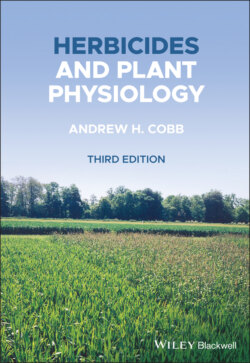Читать книгу Herbicides and Plant Physiology - Andrew H. Cobb - Страница 27
1.5.6 Seed dispersal
ОглавлениеMany weed species possess methods of both short‐ and long‐distance seed dispersal (Figure 1.2). By recognising these, it is possible to reduce the spread of weed seeds, a vital component of any integrated weed management strategy.
Table 1.9 Seed production by a number of common arable weeds and wheat.
Source: Adapted from Radosevich, S.R. and Holt, J.S. (1984) Weed Ecology: Implications for Vegetation Management. New York: Wiley; containing information from Hanf (1983).
| Weed | Common name | Seed production per plant |
|---|---|---|
| Veronica persica | Common field speedwell | 50–100 |
| Avena fatua | Wild oat | 100–450 |
| Galium aparine | Cleavers | 300–400 |
| Senecio vulgaris | Groundsel | 1100–1200 |
| Capsella bursa‐pastoris | Shepherd’s purse | 3500–4000 |
| Cirsium arvense | Creeping thistle | 4000–5000 |
| Taraxacum officinale | Dandelion | 5000 (200 per head) |
| Portulaca oleracea | Purslane | 10,000 |
| Stellaria media | Chickweed | 15,000 |
| Papaver rhoeas | Poppy | 14,000–19,500 |
| Tripleurospermum maritimum spp. inodorum | Scentless mayweed | 15,000–19,000 |
| Echinochloa crus‐galli | Barnyard grass | 2000–40,000 |
| Chamaenerion angustifolium | Rosebay willowherb | 80,000 |
| Eleusine indica | Goose grass | 50,000–135,000 |
| Digitaria sanguinalis | Large crabgrass | 2000–150,000 |
| Chenopodium album | Fat hen | 13,000–500,000 |
| Triticum aestivum | Wheat | 90–100 |
Figure 1.2 Some methods of weed seed dispersal with their estimated range in metres.
Source: Liebman, M., Mohler, C.L. and Staver, C.P. (2001) Ecological Management of Agricultural Weeds. Cambridge University Press. Reproduced with permission of Cambridge University Press.
